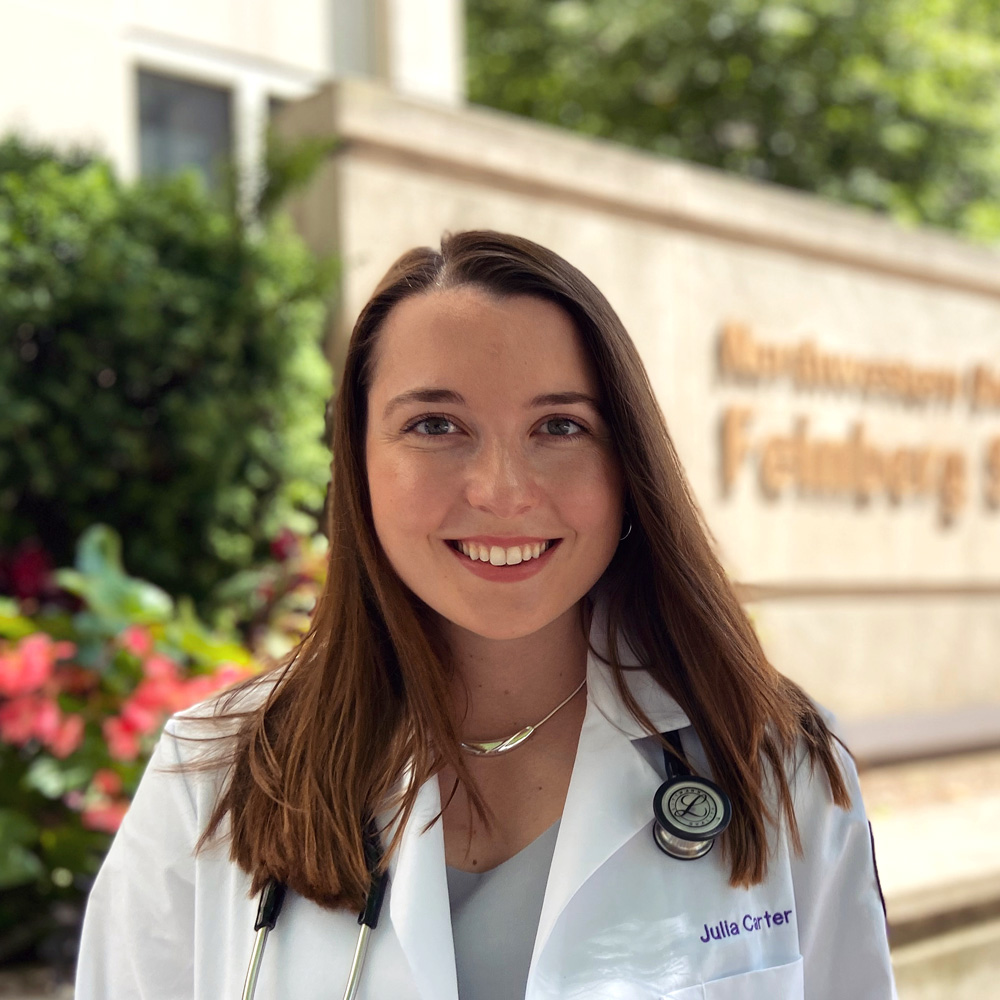Sometimes the barriers that keep a pregnant person from seeking prenatal care and all the benefits that accrue to mother and infant are in the eye of the beholder, but they can matter as much as any material obstacle.

“There’s a good amount of research looking at associations between the neighborhood environment and various health outcomes,” says Julia G. Carter, lead author on the study, Perception of Neighborhood Safety and Maternal and Neonatal Health Outcomes, published in JAMA Obstetrics and Gynecology. “When I was reviewing the literature, I saw a lack of research on the mother’s subjective experience, which is what our study looks at.”
Because individuals who live in the same community can encounter the same environment in radically different ways, Carter says the research team from Northwestern University’s Feinberg School of Medicine wanted to go beyond the data about exposure to crime and other adverse conditions to look at how the mother’s view of her personal safety affected her and her infant’s well-being.
The researchers took their data from the Pregnancy Risk Assessment Monitoring System (PRAMS), a project of the Centers for Disease Control and Prevention (CDC) which, along with state, territorial and local health departments, collects targeted, population-based attitudes on maternal attitudes and experiences surrounding pregnancy. The survey asked set questions of respondents in the participating 46 U.S. states, territories, District of Columbia and New York City, which creates data on 81 percent of all live births in the U.S. Individual states have the option of selecting additional questions to deepen their understanding of their own populations.
For their study, the Northwestern researchers analyzed responses PRAMS had gathered from 2016 to 2020 from the states that had asked respondents how they perceived their neighborhood safety.
Eight states—Illinois, Louisiana, Minnesota, Missouri, Pennsylvania, Rhode Island, Virginia and Wisconsin —asked respondents, “During the 12 months before your new baby was born, how often did you feel unsafe in the neighborhood where you lived?” Answers were then categorized as always or often unsafe, sometimes unsafe, rarely unsafe and never unsafe. To assess interpersonal physical and emotional abuse, one item asked whether respondents had been pushed, hit, slapped or physically hurt by another individual in the 12 months before they got pregnant. After 1829 exclusions, 29 987 respondents were included in the Northwestern study. Most of the respondents (78 percent) reported that they never felt unsafe. At the other end of the scale, 3 percent said they always or often felt unsafe.
The researchers then analyzed respondents’ birth outcomes including low birth weight, self-reported depression during pregnancy or postpartum, attending more than eight prenatal care visits, attending a postpartum visit, and breastfeeding for at least eight weeks.
After controlling for maternal age, race and ethnicity, and other sociodemographic factors to test the independent significance of perceived neighborhood safety, the researchers found that, compared with respondents who never felt unsafe in their neighborhoods, those reporting that they always or often felt unsafe had nearly 25 percent higher odds of having a low birthweight baby and 100 percent higher odds of perinatal depressive symptoms. The group that felt unsafe had 10 percent lower odds of attending more than eight prenatal care visits.
Although the Northwestern researchers’ cross-sectional study didn’t assess the factors that could determine why a pregnant person might choose not to seek prenatal care, their study cited an in-depth Canadian study published in the BMC Journal of Pregnancy and Childbirth that analyzed the motivators associated with inadequate prenatal care among eight inner-city Winnipeg, Manitoba, neighborhoods. Researchers from the University of Manitoba found that, although the women in their study lived in the same group of disadvantaged neighborhoods, psychosocial, attitudinal, economic and structural barriers and a variety of motivators, separated those women who received adequate prenatal care from those who did not. The study highlights the diversity among inner-city women with respect to their experiences with prenatal care and their perceptions of factors that help or hinder them in accessing this care.
Psychosocial issues that increased the mothers’ likelihood of not receiving adequate care included feeling stressed, having family problems, being depressed and worrying that child welfare officials might take the baby. Being abused by their husband or boyfriend also prevented several of the women from obtaining adequate prenatal care. Structural barriers included not knowing where to get prenatal care or having a long wait to get an appointment. Problems with transportation or child care were mentioned by nearly half the women who didn’t receive adequate prenatal care.
The good news, Carter says, is that these factors have policy implications, which means they can be addressed. Solutions are more likely to be found in such initiatives as providing access to social workers who can help with scheduling and follow up, providing mental health resources, or addressing systemic issues such as the lack of bus stops near clinics.
A reverse image of the neighborhood perception study can be found in the paper, “Prenatal Exposure to Favorable Social and Environmental Neighborhood Conditions is Associated with Healthy Pregnancy and Infant Outcomes,” published in the International Journal of Environmental Research and Public Health, which looks at the relationship between favorable social and environmental neighborhood conditions and perinatal outcomes.
Researchers from the University of Albany looked at nearly 300 mother-infant pairs in small cities, suburban regions and rural areas in upstate New York. The neighborhoods were analyzed according to the Child Opportunity Index (COI), a multidimensional indicator of a neighborhood’s favorable social, environmental and educational community attributes. The study, the first to analyze the COI in association with pregnancy health and birth size, demonstrated that positive neighborhood attributes cumulatively contributed to healthy pregnancies and favorable birth outcomes.
While the idea that better neighborhoods make for better health may seem like a foregone conclusion, the contrast among the studies underscores an important point. The factors that give one neighborhood a high COI score and make other neighborhoods a source of fear and concern for mother and child, are all malleable and subject to change.
In their neighborhood perception paper, the Northwestern researchers point out that social and economic interventions that combat neighborhood and domestic violence may be more beneficial in reducing adverse pregnancy outcomes than biomedical interventions. Reducing expensive, often counterproductive police crime-prevention initiatives and mass incarceration in favor of resources that strengthen low-income communities may go further to create a sense of safety not only for pregnant people, but for the entire community.
“The main question,” Carter says, “is what are we going to do about it? That is outside the scope of our study, but assessing the situation is the first step in having this conversation. There are still a lot of steps to make improvements and develop solutions.
“With these social determinants of maternal health, the truth is, there’s no quick fix. But to have the data and the commitment to collectively do something about it makes a big difference.”
Further Reading
Perception of Neighborhood Safety and Maternal and Neonatal Health Outcomes authors are Julia G. Carter, BS; Joe M. Feinglass, PhD; Lynn M. Yee, MD, MPH; Northwestern University Feinberg School of Medicine, Chicago, Illinois.
Parents perception of neighborhood safety and children’s physical activity Children from neighborhoods perceived as unsafe by parents engaged in one less day per week in physical activity. Children from neighborhoods perceived as unsafe were less likely to use recreational facilities compared with children from neighborhoods perceived as safe, and children from less affluent families across rural and urban areas had half the odds of using recreational facilities compared with children from the wealthiest families living in urban areas.
Perception of neighborhood safety and reported childhood lifetime asthma in the United States (U.S.): a study based on a national survey Neighborhoods can be a potential source of psychosocial stressors associated with childhood asthma. Parents who perceive their neighborhoods as sometimes or never safe reported asthma at higher rates than those living in neighborhoods parents perceived to be always safe.

K.C. Compton
K.C. Compton worked as a reporter, editor and columnist for newspapers throughout the Rocky Mountain region for 20 years before moving to the Kansas City area as an editor for Mother Earth News. She has been in Seattle since 2016, enjoying life as a freelance and contract writer and editor.


